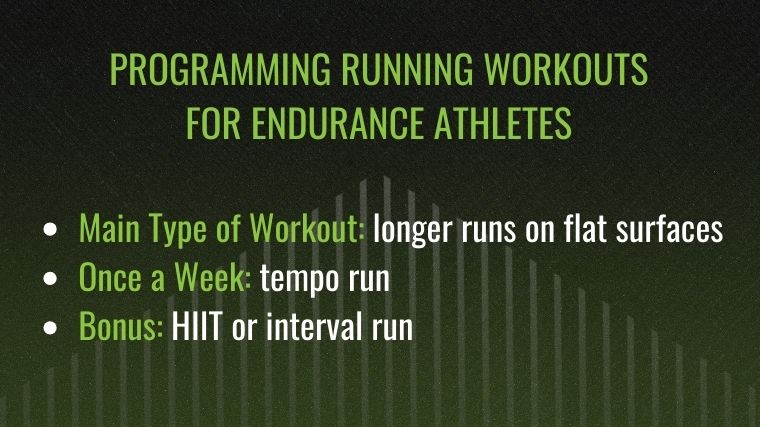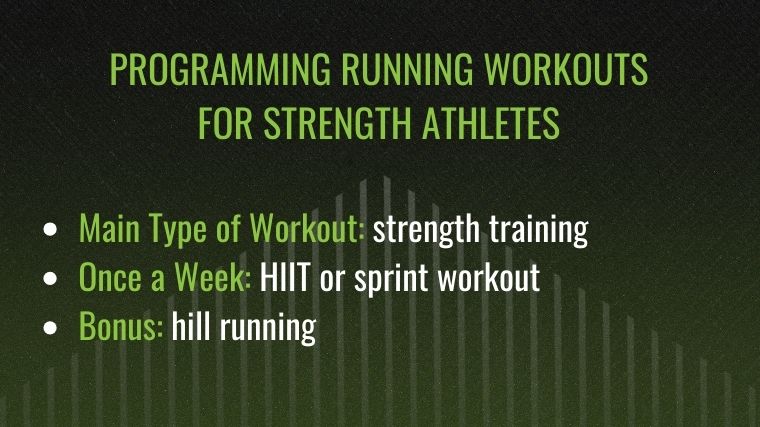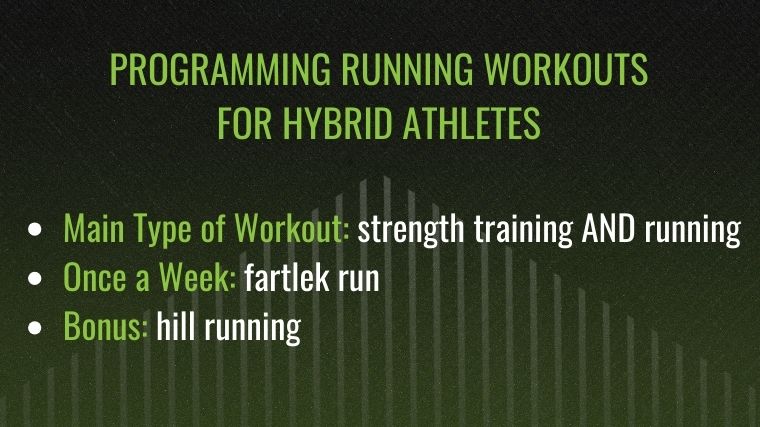Running and strength training are different beasts, to be sure. For one thing, running is about variety. Yes, there’s some variety in lifting weights, too. But for the most part, your resistance training sessions will look more or less the same from day to day. Contrary to its reputation as the “boring” one, running workouts…really change it up from one day to the next.

Here, I’ll break down the five best running workouts to give you an overview of the different types of runs your program needs. We’ll run (pun intended) through how to vary interval training with speed and incline; longer runs; tempo runs; speed work; and how to get started for beginners. Each type of running workout will help you build strength, speed, and endurance while increasing your aerobic capacity. In other words — you’ll become a better overall athlete.
The 5 Best Running Workouts
- HIIT Running Workout
- Tempo Running Workout
- Beginner Running Workout
- Hill Running Workout
- Interval Running Workout
HIIT Running Workout
It may be…well, intense…but high-intensity interval training (HIIT) is also fairly straightforward. Here’s how it goes: You alternate short bursts of all-out effort with short rest or recovery periods. The shorter the all-out sprint, the harder and faster you should run.
The idea is to spike your heart rate during sprints and let it recover during rest periods. HIIT is great for a quick cardio workout that you can complete in five to 20 minutes.
The Workout
HIIT workouts are challenging — this one isn’t for newbies, and the risk of injury may be higher if you’re not used to sprinting.
After a dynamic warm-up, you can perform this running workout on a treadmill or outside. You’ll alternate 30-second, all-out sprints with one-minute recovery periods for 10 to 12 rounds.
[Read More: The Best Budget Treadmills]
Remember that what’s high-intensity for you might be “easy” for someone with more experience — and that’s OK. Keep it at your own level, and make adjustments wherever you need.
How Often to Do This Workout: Try this once or twice weekly to see how you feel before adding more frequency.
Modifications
- Make it Easier:
- Take a complete rest during some or all of the recovery periods
- Instead of doing 30-second sprints every time, scale up.
- 15-second all-out sprint, 75-second jog or walk
- 20-second all-out sprint, 70-second jog or walk
- 30-second all-out sprint, 60-second jog or walk
- Repeat this sequence for three to four rounds
- Instead of the sequence, you can choose one of the shorter options for the entire workout:
- 15-second all-out sprint, 75-second jog or walk for 10 to 12 rounds
- 20-second all-out sprint, 70-second jog or walk for 10 to 12 rounds
- Make it Harder:
- Shorten the sprint and try to run harder, but keep the recovery period the same.
- Add a distance goal for your sprints.
Tempo Running Workout
Tempo runs (or threshold runs) are another type of workout for advanced runners. Exercise physiologist and running coach Dr. Jack Daniels, Ph.D., developed the concept of tempo runs.
A tempo run is a short run (20 to 40 minutes, or a 5K to 10K) where you run at a “comfortably hard” effort for the entire time. Interval workouts should feel very hard in your all-out bursts, but tempo runs are just below that effort so that you can sustain it for longer. (1)
[Read More: The Best Treadmills for Walking, Researched and Tested by Our Team]
Though relatively short, tempo runs are meant to improve long-distance running by increasing your lactate threshold. Your lactate threshold is the highest intensity you can run where your body can balance lactate buildup and removal. When you cross the threshold, your muscles can’t continue. (2)
The idea is that running just below the lactate threshold will help increase your time before fatiguing and build your endurance for long-distance runs, which makes them popular in marathon training.
The Workout
A tempo run consists simply of a warm-up, a 20 to 40-minute run, and a cool-down. But you need to calculate your tempo pace, which is different for everyone.
Here are a few methods that Dr. Daniels offers to find your tempo pace. (1)(3)
- Run at 83 to 88 percent of your VO2 max.
- Run at 88 to 92 percent of your maximum heart rate.
- Run at a six out of 10 RPE, or use the talk test — fast enough that you can’t hold a conversation.
- Plug your previous race times into his VDOT table.
When you know your tempo pace, perform a dynamic warm-up and hop into the workout.
How Often to Do This Workout: You only need to do tempo runs once a week.
Modifications
- Make it Easier:
- When you calculate your tempo pace, you can go slower for your first attempt.
- Though 20 minutes is the minimum for a technical tempo run, you can certainly start with trying 10 minutes.
- Make it Harder:
- A tempo run can go as long as 40 minutes. Try adding a few minutes each week.
Beginner Running Workout
Ready to start running? First, let’s define a beginner. You may have a high fitness level in weightlifting but never run before, or you could be a complete fitness newbie.
[Read More: Expert Tested: The 8 Best Treadmills for Running]
Either way, starting slow and incorporating (or keeping) strength training in your overall workout routine is essential. Building strength outside of your runs may lower your risk of injury — plus, the stronger your legs are, the better your base can be.
The Workout
This beginner workout is gentle on your joints and alternates slow jogs with walks. This will help you build endurance in a lower-intensity cardio workout. It’s a 1:1 ratio, meaning you jog for the same length of time you walk and repeat it for 20 minutes. I’ll also give you ideas for making that ratio easier or harder and how to build up to a longer jog.
How Often to Do This Workout: Try this once or twice weekly. You can build up from there.
Modifications
- Make it Easier:
- Take a 30-minute brisk walk and skip the running to start
- Play with the ratios; jog for one minute and walk for three to five minutes.
- Make it Harder:
- Try this workout for a few weeks, increasing difficulty over time:
- Make the jogging sections longer while keeping the walk the same until you reach five minutes of jogging and one minute of walking. Then, take the jogging back to one minute but shorten the walk to 30 seconds.
- Once you can do three or four sets of five-minute runs with 30-second walks, you can try a steady-state jog or run to build endurance and aerobic capacity. Jog at an easy pace for 20 minutes straight.
- Try this workout for a few weeks, increasing difficulty over time:
Hill Running Workout
Hill running workouts are a great way to build strength that may be gentler on your joints than fast running on flat surfaces. Running uphill causes less impact and force on your joints while calling for more muscle activation from your glutes and hamstrings. You can do them outside or as a treadmill incline workout to better control your inclines.
The Workout
There are many ways to manipulate a hill running workout. You could run intervals by varying your inclines on a treadmill or outside in a hilly area. You can also steadily run one big hill for more of a steady-state cardio workout that helps build endurance and strength. You can alternate speeds and intensities or keep them the same.
[Read More: How Many Steps in a Mile? Calculate by Height and Pace]
This workout offers a little bit of everything but is meant to be steady-state, where you maintain roughly the same heart rate for the entire time. You’ll alternate between two speeds, running slower at a higher incline and faster at a lower incline. It’s easiest to do this on a treadmill.
How Often to Do This Workout: You can do this workout two to three times a week.
Modifications
- Make it Easier:
- You’ll have to experiment with the inclines to find what best sustains a moderate heart rate for you. To make it easier, start with both incline and speed on the lower end.
- Make it Harder:
- Set a high incline and maintain it for 30 minutes, like the popular walking 12-3-30 workout. Since this is a running workout, you’ll want to go faster than a 3.0 speed, so you’ll need to play around to find the appropriate incline.
Interval Running Workout
There are endless ways to create an interval running workout that can help you increase your running speed. This one is going to be a fartlek run. Fartlek is a Swedish word that means “speed play.”
Swedish running coach Gösta Holmér coined fartlek training. These are continuous runs that vary in intensity, pace, and duration, with slower, easy runs as recovery periods rather than complete rest. Though it’s a type of interval training, it differs because it is meant to be unstructured, hence “speed play.”

[Read More: The Best Nordictrack Treadmills — Yes, We Tested Them All]
You choose your intervals and intensity by how it feels rather than sticking to specific paces, heart rates, or distances. Initially, they were done in forests rather than a track, utilizing natural terrain for variety. (4)
Fartlek workouts should bring fun and variety to a structured running training program. They give you a mental break and can also help you tune into your body’s cues on what feels like a hard, moderate, or easy pace. You can gauge rest times based on your body rather than sticking to the clock.
The Workout
A true fartlek workout doesn’t have a structure. Some runners make up fartlek runs as they go based on landmarks. For example, sprint to that lamppost, jog to the next tree, run up that hill, walk back down, and repeat.
[Read More: Expert Tested: The Best Cushioned Treadmills on the Market]
If you do it at the gym, you can also make it up based on a song you’re listening to. Sprint during the chorus and jog until the next one. If you’re watching television on a treadmill, sprint until the next commercial break, jog until the scene changes…get creative.
Here is a sample fartlek workout to try. The idea is to feel out your paces without checking your heart rate, time, or distance.
How Often to Do This Workout: Incorporate this once a week. Your other structured runs still matter in making progress.
Modifications
- Make it Easier:
- Another sample structure for a fartlek run is to decide how many miles you want to do. Sprint for as long as you can at the top of each mile; let the rest be a recovery run. Repeat at the top of each mile.
- Make it Harder:
- Choose “random” on a treadmill.
- Make it an interval workout without timing anything. Alternate sprints with recovery runs, but change the length of each one based on how you feel in the moment.
How to Program Running Workouts
If you’re wondering how to incorporate these running workouts into your workout program, it depends on the type of athlete you are and your goal. Getting specific will help you get the results you want. Here are some ideas.
For Endurance Athletes
Endurance athletes will want to do longer runs on flat surfaces to build aerobic capacity. Doing shorter tempo runs can also build endurance by training your muscles to continue removing lactic acid for longer.

- Try adding a tempo run once weekly in addition to your long-distance training.
- Adding a HIIT or interval running workout to your week can also increase endurance.
For Strength Athletes
Strength athletes likely already have a packed training program, so you’ll need to get creative with your program.

- Add a HIIT sprint workout after one lifting session per week to boost your body conditioning.
- Add one hill running workout to your week. You likely already have strong lower body muscles and may enjoy the challenge.
For Hybrid Athletes
For those who like a little bit of everything, incorporate speed work in shorter runs and build endurance in longer runs.

- Try a fartlek workout once per week.
- Add the hill running workout to keep your muscles engaged.
To Run Faster
If running faster is your goal, you’ll want to work on short and fast sprints. Tempo runs help, too.

- Do one HIIT running workout per week.
- Make sure you are doing at least one slow recovery run per week, even when you’re trying to get faster. This will keep your aerobic fitness up and help stave off potential burnout.
To Run Longer
For distance runners, varying your pace throughout a longer run can help you sustain your effort for longer. If you’re new to running, start with short runs that alternate jogging with walking and build up over time.

- Newbies can try the beginner running workout and follow my idea for progressing over time.
If you’re not a newbie:
- A fartlek run or other type of longer interval workout where you alternate a faster and slower pace can help you run for longer. Add one per week.
- Tempo runs, again, come in clutch for this goal. Consider adding one tempo run per week.
Frequently Asked Questions
What is a good workout for running?
It depends on your fitness level and goals. For newbies, try the beginning running workout and plenty of strength training. For intermediate and experienced runners, mixing in longer runs with speed work helps improve performance.
What does 30 minutes of running do?
Running for 30 minutes is a challenging hiit cardio workout. It improves cardiovascular health and fitness and builds endurance. It’s also a high-impact exercise, which can increase your risk of injury if you aren’t used to it. Build up gradually to running 30-minutes non-stop.
What are the benefits of running?
Running improves cardiovascular health and fitness, builds endurance, and can boost your mood. For many, it’s also an extremely enjoyable activity.
How long should you run each day?
Again, it depends on your fitness goal and levels. You can do a solid run in 10 to 20 minutes, especially as a beginner. As you become more advanced, the less time you spend running, the higher the intensity will be. Distance runners may run for an hour or more with varying intensity.
Editor’s Note: The content on BarBend is meant to be informative in nature, but it should not be taken as medical advice. When starting a new training regimen and/or diet, it is always a good idea to consult with a trusted medical professional. We are not a medical resource. The opinions and articles on this site are not intended for use as diagnosis, prevention, and/or treatment of health problems. They are not substitutes for consulting a qualified medical professional.
References
- Daniels, J. (2013). Daniels’ running formula. Human Kinetics.
- Støa, E. M., Helgerud, J., Rønnestad, B. R., Hansen, J., Ellefsen, S., & Støren, Ø. (2020). Factors Influencing Running Velocity at Lactate Threshold in Male and Female Runners at Different Levels of Performance. Frontiers in Physiology, 11, 585267.
- Daniels, J., Ph.D. (2005, December 1). Threshold Training: Finding Your VDOT. Runner’s World.
- Casado A, Foster C, Bakken M, Tjelta LI. Does Lactate-Guided Threshold Interval Training within a High-Volume Low-Intensity Approach Represent the “Next Step” in the Evolution of Distance Running Training? Int J Environ Res Public Health. 2023 Feb 21;20(5):3782.
The post The 5 Best Running Workouts to Level Up Your Conditioning appeared first on BarBend.

